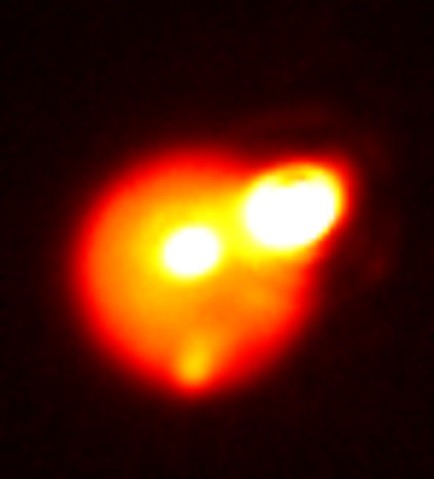Io Blasted by the Most Violent Volcanic Eruptions in the Solar System
| Ana Verayo | | Aug 06, 2014 03:47 AM EDT |
The massive volcanic eruptions on Io taken by the Gemini North telescope ( Katherine de Kleer, UC Berkeley)
A series of indescribably massive volcanic eruptions rent Jupiter's moon, Io, over the course of two weeks.
Io is the most volcanically active planetary body in the solar system. Three colossal eruptions blasted large amounts of of Io's surface into space and were visible to astronomers on Earth.
Like Us on Facebook
The first two massive eruptions recorded by Dr. Imke de Pater of University of California, Berkeley took place in Io's southern hemisphere on August 15.
De Pater said these huge eruptions were thought to be a rare event since only one massive eruption occurs every one or two years.
These massive eruptions were recorded by a Near-Infrared Camera on the Keck II telescope, one of two telescopes operated by the Keck Observatory in Hawaii.
Io is the closest moon to Jupiter and is among the four "Galilean" moons that orbit the planet.
It is about the size of our moon but is the only known moon in the solar system that produces lava as hot as volcanoes on Earth.
Since Io has a low gravity, eruptions like these spew masses of debris at a much farther distance and rate.
The brightest eruption was a tremendous blast in a caldera or an opening caused by a volcanic eruption. Scientists estimate the lava flow at some 50 square miles and around 30 feet thick. This caldera is called Rarog Patera.
The second eruption, which was close to another caldera called Heno Patera, produced lava flows that measured 120 square miles.
But the brightest eruption ever seen and recorded from Io was discovered on August 29. It was recorded by two telescopes: the Gemini North telescope in Mauna Kea and NASA's Infrared Telescope Facility nearby.
According to NASA, these massive and powerful explosions caused Io's surface to bulge 330 feet where "curtains of fire" several miles long escaped from its surface.
This unusual volcanic activity was caused by tidal forces from Jupiter and the other Jovian moons, Europa and Ganymede.
Researchers concluded that these volcanic eruptions were 10,000 times more powerful than the Eyjafjallajokull eruption in Iceland last 2010.
The energy emitted by these eruptions was about 20 terawatts, which is enough energy to power the entire Earth for a year.
TagsBrightest Volcano Eruption in Space is from Jupiter's Moon, Io, Jupiter, Io, jupiter moon, jupiter moon volcano, volcanic eruptions, volcanic eruptions in space, brightest volcanic eruption, NASA, jupiter moon photo, jupiter moon volcanic eruption photo, most powerful volcanic eruption in space, volcano eruption
©2015 Chinatopix All rights reserved. Do not reproduce without permission
EDITOR'S PICKS
-

Did the Trump administration just announce plans for a trade war with ‘hostile’ China and Russia?
-

US Senate passes Taiwan travel bill slammed by China
-

As Yan Sihong’s family grieves, here are other Chinese students who went missing abroad. Some have never been found
-

Beijing blasts Western critics who ‘smear China’ with the term sharp power
-

China Envoy Seeks to Defuse Tensions With U.S. as a Trade War Brews
-

Singapore's Deputy PM Provides Bitcoin Vote of Confidence Amid China's Blanket Bans
-

China warns investors over risks in overseas virtual currency trading
-

Chinese government most trustworthy: survey
-

Kashima Antlers On Course For Back-To-Back Titles
MOST POPULAR
LATEST NEWS
Zhou Yongkang: China's Former Security Chief Sentenced to Life in Prison

China's former Chief of the Ministry of Public Security, Zhou Yongkang, has been given a life sentence after he was found guilty of abusing his office, bribery and deliberately ... Full Article
TRENDING STORY

China Pork Prices Expected to Stabilize As The Supplies Recover

Elephone P9000 Smartphone is now on Sale on Amazon India

There's a Big Chance Cliffhangers Won't Still Be Resolved When Grey's Anatomy Season 13 Returns

Supreme Court Ruled on Samsung vs Apple Dispute for Patent Infringement

Microsoft Surface Pro 5 Rumors and Release Date: What is the Latest?










